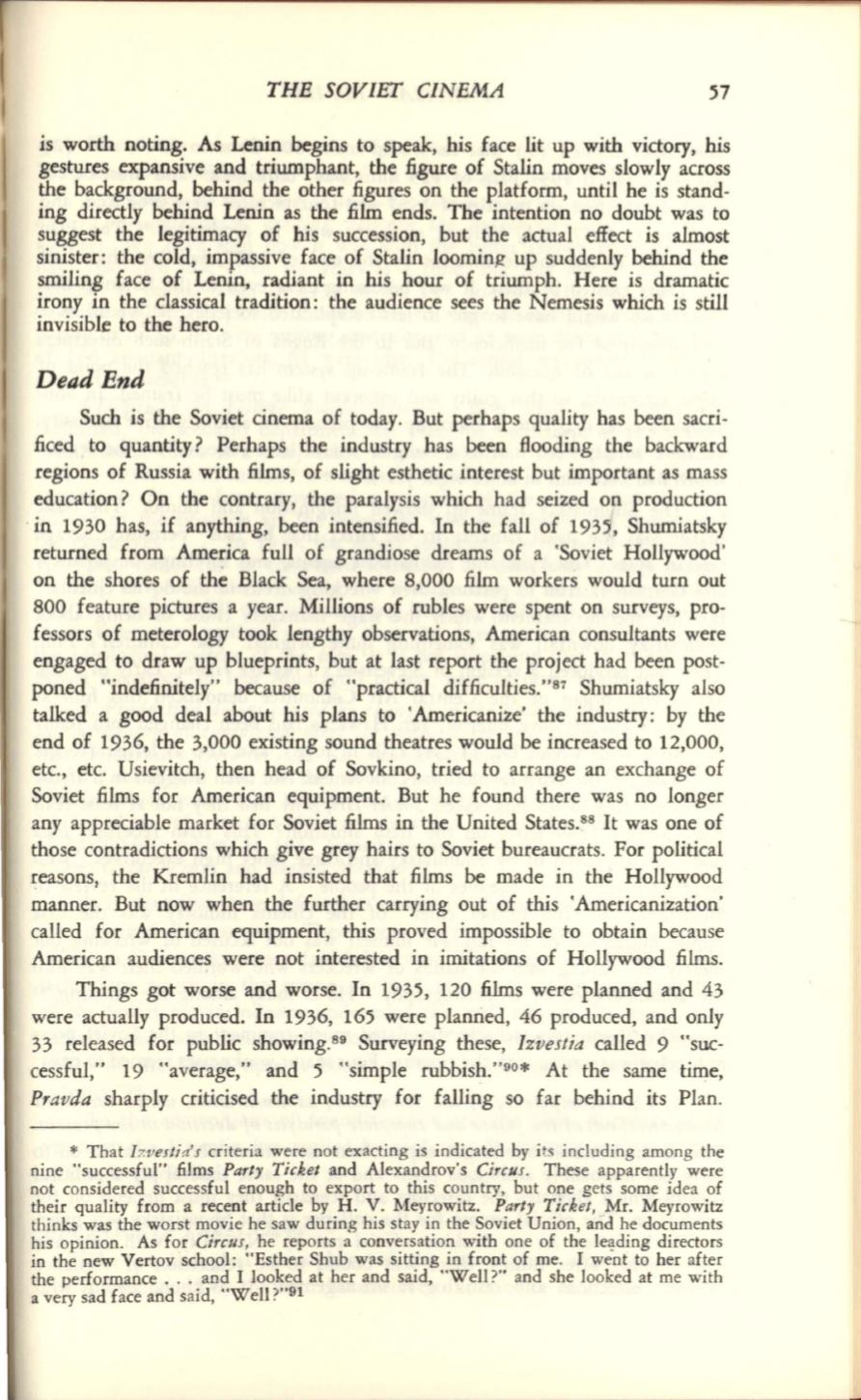
THE SOVIET CINEMA
57
is worth noting. As Lenin begins to speak, his face lit up with victory, his
gestures expansive and triumphant, the figure of Stalin moves slowly across
the background, behind the other figures on the platform, until he is stand–
ing directly behind Lenin as the film ends. The intention no doubt was to
suggest the legitimacy of his succession, but the actual effect is almost
sinister : the cold, impassive face of Stalin looming up suddenly behind the
smiling face of Lenin, radiant in his hour of triumph. Here is dramatic
irony in the classical tradition : the audience sees the Nemesis which is still
invisible to the hero.
Dead End
Such is the Soviet cinema of today. But perhaps quality has been sacri–
ficed to quantity? Perhaps the industry has been flooding the backward
regions of Russia with films, of slight esthetic interest but important as mass
education? On the contrary, the paralysis which had seized on production
. in
1930
has, if anything, been intensified. In the fall of
193{
Shumiatsky
returned from America full of grandiose dreams of a 'Soviet Hollywood'
on the shores of the Black Sea, where
8,000
film workers would turn out
800
feature pictures a year. Millions of rubles were spent on surveys, pro–
fessors of meterology took lengthy observations, American consultants were
engaged to draw up blueprints, but at last report the project had been post–
poned "indefinitely" because of "practical difficulties.
"S7
Shumiatsky also
talked a good deal about his plans to 'Americanize' the industry : by the
end of
1936,
the
3,000
existing sound theatres would be increased to
12,000,
etc., etc. Usievitch, then head of Sovkino, tried to arrange an exchange of
Soviet films for American equipment. But he found there was no longer
any appreciable market for Soviet films in the United States.
ss
It was one of
those contradictions which give grey hairs to Soviet bureaucrats. For political
reasons, the Kremlin had insisted that films be made in the Hollywood
manner. But now when the further carrying out of this 'Americanization'
called for American equipment, this proved impossible to obtain because
American audiences were not interested in imitations of Hollywood films.
Things got worse and worse. In
1935, 120
films were planned and
43
were actually produced. In
1936, 165
were planned,
46
produced, and only
33
released for public showing.
s9
Surveying these,
Izvestia
called
9
"suc–
cessful,"
19
"average," and 5 "simple rubbish." 90* At the same time,
Pravda
sharply criticised the industry for falling so far behind its Plan.
*
That
h:vestia's
criteria were not exacting is indicated by its including among the
nine "successful" films
Party Ticket
and Alexandrov's
Circus.
These apparently were
not considered successful enough to export to this country, but one gets some idea of
their quality from a recent article by H. V. Meyrowitz.
Party Ticket,
Mr. Meyrowitz
thinks was the worst movie he saw during his stay in the Soviet Union, and he documents
his opinion. As for
Cirms,
he reports a conversation with one of the
le~ding
directors
in the new Vertov school : "Esther Shub was sitting in front of me. I went to her after
the performance . .. and I looked at her and said, "Well ?" and she looked at me with
a very sad face and said, "Well ?"91


